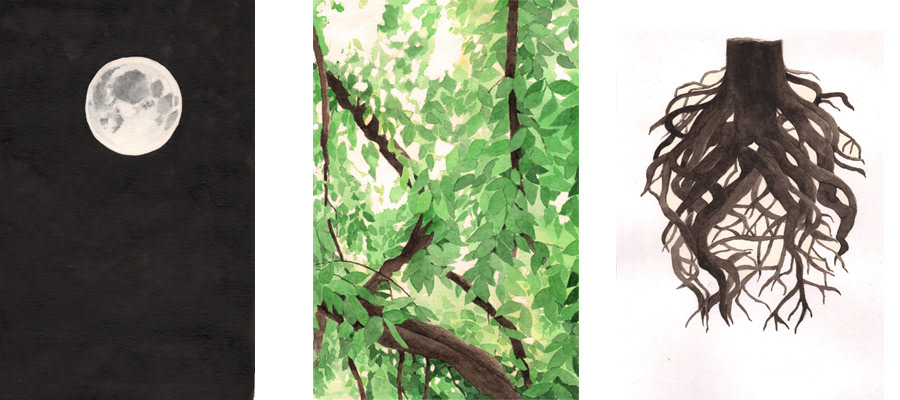Naturalis Historia: The Natural History of Trees
Graphite pencil drawings, watercolour paintings, text
Graphite pencil drawings, watercolour paintings, text

Moon, Foliage, Roots. (Watercolours)
"Naturalis Historia" is the title in Latin, for one of the largest single works to have survived from the Roman Empire to the modern day. It is an encyclopedic work, dating from circa 77 AD, authored by Pliny the elder.
The Natural History consists of 37 books, and covers amongst other things anthropology, botany, geography, mathematics, medicine, zoology and mineralogy. Eight of these books, no:s 12-17 and 23-24, are devoted to the natural history of trees.
Pliny's books on the natural history of trees - the characteristics, the uses and the history of trees - are the starting point for this project and exhibition. The drawings, paintings and texts reflect the ideas presented by Pliny, his thoughts that represent how he and his peers looked at science and knowledge. As well as how they looked at nature and trees, and what part nature plays in relation to culture and society.

View from the exhibition.

Forest (Corylus I)
Graphite pencil drawing, 62 cm x 44 cm


View from the exhibition. The Natural History of Trees (After Pliny), handmade book. Moon, Foliage, Roots, Timber, watercolour paintings.
A handmade book, with texts that deal with the subjects of trees, was exhibited as part of the exhibition. The texts deal with trees in different ways, for instance, the body of the tree, the life and death of a tree, its medicinal uses, felling of timber, and so on. The texts are paraphrasing the information that is given about trees in Pliny's encyclopedic work "Naturalis Historia".

Excerpts from the section "Some Effects and Uses of Trees" “... Several trees and their bark, branches, leaves, roots, etc., are used for medicinal purposes. For instance, the red bark of the roots of wild pomegranate can be used as a hypnotic and will induce sleep if it is taken with wine.”
“... The effects that some trees have are harmful, or hazardous, to human beings. The milax, or the yew-tree, has a poison so potent that people who fall asleep beneath this tree, or even picnic beneath it, will die.”
“... The effects that some trees have are harmful, or hazardous, to human beings. The milax, or the yew-tree, has a poison so potent that people who fall asleep beneath this tree, or even picnic beneath it, will die.”


